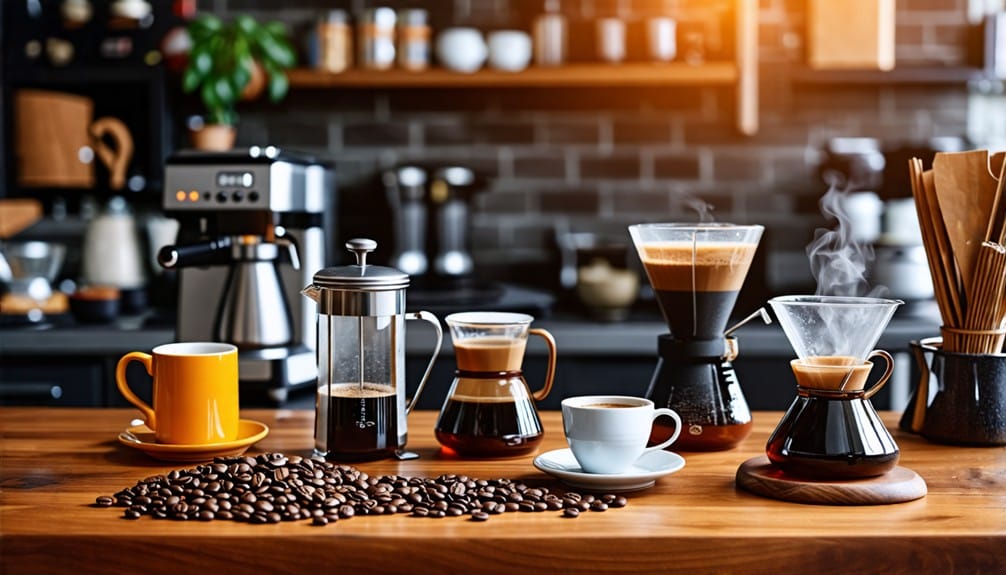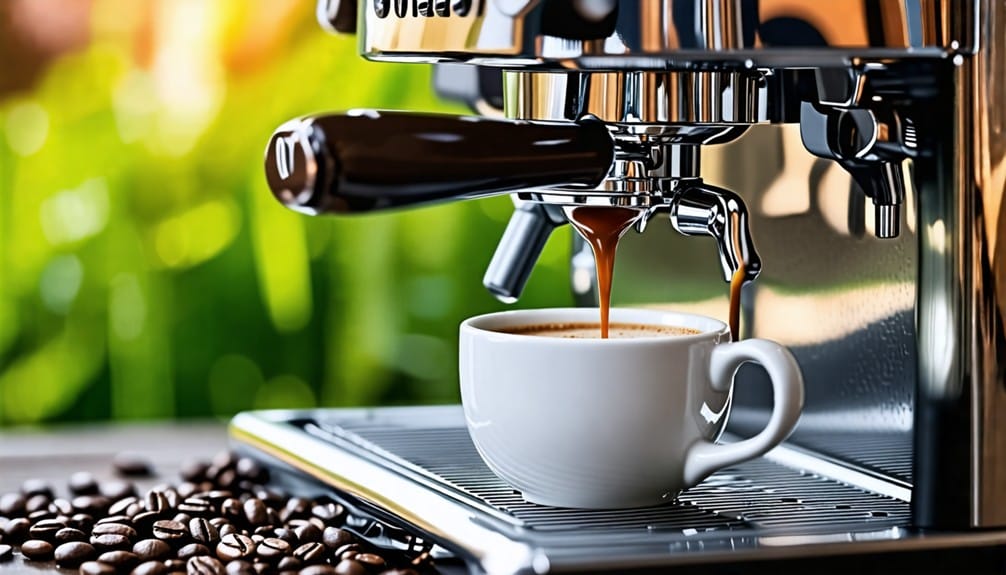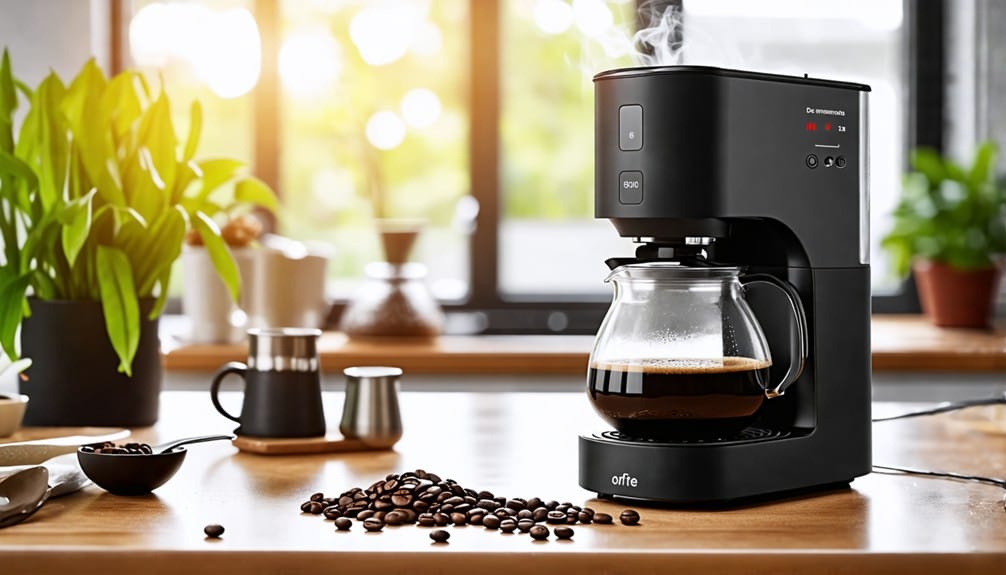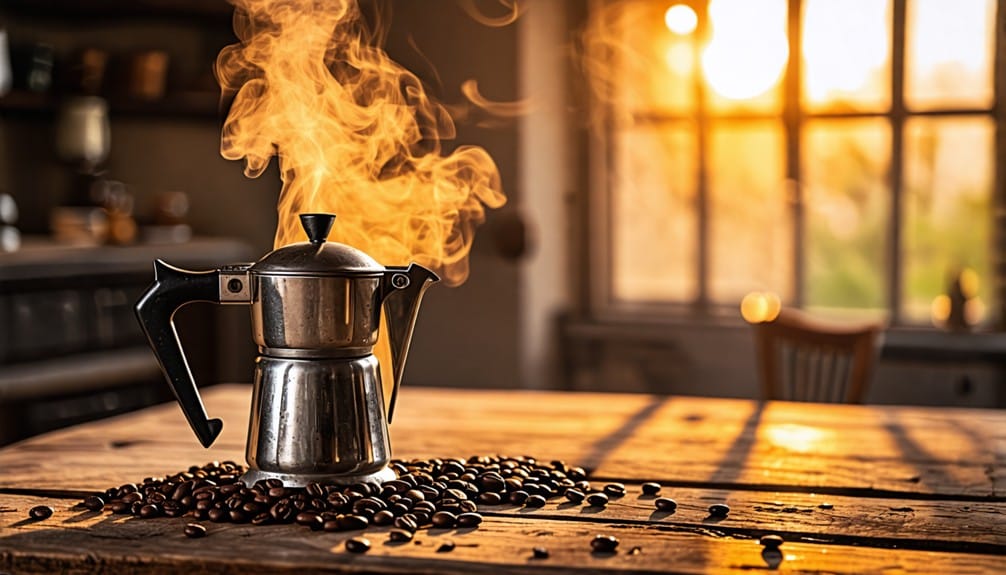Physical Address
304 North Cardinal St.
Dorchester Center, MA 02124
Physical Address
304 North Cardinal St.
Dorchester Center, MA 02124

When it comes to coffee brewing methods, you’ve got options galore! You can try the pour-over for a clean taste or steep coarsely ground coffee in a French press for a smooth experience. If you’re feeling fancy, whip up some espresso or use an AeroPress for a rich cup in minutes. Don’t forget about the convenience of drip machines for consistent brews. For those adventurous souls, vacuum siphon coffee is a visual treat, while cold brew offers an invigorating twist. Each method brings out unique flavors, so grab your favorite beans and explore. You might just find your new favorite!
Have you ever tried the pour-over method, which gives you complete control over your brewing process for a cleaner, more flavorful cup of coffee? This manual brewing technique allows you to experiment with different variables, such as water temperature, pouring speed, and even the direction of your pour.
With the right equipment, like a Hario V60 or Chemex, you can truly elevate your coffee experience.
To get started, you’ll want a medium-fine grind of ground coffee. Don’t skip the blooming process—pour a small amount of water over the coffee first to release those gases and enhance the flavor.
Using freshly boiled water at 195-205°F is essential, as it helps extract all those delightful notes without bitterness.
One of the best parts about the pour-over method is the clarity of flavor it delivers. You’ll notice your coffee’s unique tasting notes shining through like stars in the night sky.
With a little practice, you’ll master this brewing process and impress your friends. Plus, who wouldn’t want to sip on a cup of coffee that feels like a work of art? So grab your gear and get brewing!
The French press method delivers a rich, full-bodied coffee experience by steeping coarsely ground coffee in hot water for about four minutes before pressing down the plunger.
This simple brewing technique is a favorite among coffee lovers for good reason! You’ll want to use a coarse grind size that resembles breadcrumbs or coarse salt to get started. This helps prevent bitterness and keeps your coffee tasting smooth. A good coffee-to-water ratio is roughly 1:15. That means for every liter of water, you’d use about 56 grams (or 8 tablespoons) of coffee.
Feel free to tweak this ratio based on your taste preferences! Before you pour in all that hot water, try the blooming technique. Just wet the coffee grounds with a little hot water first. This releases trapped gases and enhances the flavor and aroma.
Once your four minutes are up, press down the plunger and serve your coffee right away. Don’t let it sit in the French press; it might turn bitter. Enjoy your delicious brew; remember, life’s too short for bad coffee!

Espresso coffee packs a powerful punch of flavor and aroma thanks to its unique brewing method that uses high pressure to extract the best from finely ground beans.
When you use espresso machines, you’re harnessing vapor pressure to force nearly boiling water through your coffee grounds.
To brew a perfect shot, you’ll need to grind your beans very fine—think powdered sugar consistency.
This grind size is vital for creating that necessary pressure and achieving the rich flavors you crave.
Typically, you should aim for a brew time of 25 to 30 seconds and a coffee-to-water ratio of about 1:2.
In simpler terms, for every gram of coffee, add about two grams of water.
Don’t be afraid to experiment with different beans and temperature settings!
Whether you prefer a straight shot or a creamy latte, espresso serves as the foundation for many delicious coffee drinks.
The AeroPress might be the perfect choice if you’re looking for a versatile and portable brewing method.
This nifty gadget combines immersion and pressure brewing techniques to whip up coffee that can rival your local café. Thanks to its quick brew time, you can enjoy a rich cup in just 1 to 2 minutes.
What makes the AeroPress really stand out is its flexibility with the coffee-to-water ratio. You can play around with ratios from 1:12 to 1:16, allowing you to brew everything from a strong espresso-like shot to a milder cup.
And don’t worry about grit; the micro-filter guarantees your coffee is smooth and free from any unwanted particles.
Cleaning up is a breeze, too! Just pop out the filter and grounds, rinse, and you’re done—no fuss, no mess.
Plus, with consistent results, you’ll find that each cup has reduced acidity and bitterness, making your coffee experience even better.

Drip coffee machines offer a convenient way to brew a consistent, flavorful cup of coffee with minimal effort.
These machines use an automated pour-over process, where hot water drips evenly over your ground coffee, producing a clean brew in about 5 to 10 minutes. You won’t have to worry about babysitting your coffee.
To achieve the best drip coffee, pay attention to the coffee-to-water ratio. A common guideline is 1:16, meaning you’d use about 55 grams of coffee for each liter of water. You can tweak this to match your taste—stronger or milder, it’s up to you.
The grind size is also vital. A medium grind, like sea salt, works best. Too coarse, and you might end up with a weak cup; too fine, and you risk bitterness.
The real charm of drip coffee machines lies in their convenience. They brew several cups at once, perfect for families or guests. Plus, you can rely on them for consistent results every day. So, if you want a hassle-free way to enjoy your coffee, a drip coffee machine might just be your new best friend.
Cold-brew coffee offers a smooth, rich flavor by steeping coarsely ground coffee in cold or room-temperature water for 12 to 24 hours.
This brewing process allows for a unique extraction that results in a less acidic cup compared to traditional methods. You’ll want to keep the coffee-to-water ratio in mind; a common mix is about 1:4 or 1:5.
This means one part coffee to four or five parts water, creating concentrated coffee that can be diluted to your liking.
One of the best parts is that you can use just about any container, like a mason jar or pitcher, so you don’t need fancy equipment.
Once you brew it, you can store cold brew in the fridge for up to two weeks—perfect for those busy mornings!
When it comes to the flavor profile, expect rich, chocolatey notes with minimal bitterness.
This makes cold brew a fantastic choice for anyone sensitive to acidity.
So, whether you sip it straight, pour it over ice, or mix in milk, you’re in for a delightful treat.
Just remember, patience is key—good things take time, even in the world of coffee!

Moving from the smooth richness of cold brew, percolated coffee offers a robust and full-bodied flavor that many coffee enthusiasts cherish.
To brew this delightful cup, you’ll need to understand a few key elements. First, the coffee grind size matters—a medium-coarse grind is essential. This helps achieve a balanced extraction, preventing your brew from turning into a bitter concoction that could scare off even the bravest caffeine lovers.
Next up is water temperature. You want to heat your water to a rolling bubble, then reduce the heat to low. This prevents boiling, which can lead to over-extraction (and trust me, no one wants bitter coffee!).
The brewing time typically ranges from 7 to 10 minutes. Keep an eye on it; you don’t want to leave it on too long, or you’ll end up with something that could double as motor oil!
The result? A rich, full-bodied coffee that’s perfect for those chilly mornings or cozy evenings. So grab your percolator and get ready to enjoy a cup of nostalgia that reminds you of camping trips and great conversations!
With its unique brewing mechanism, vacuum or siphon coffee captivates both the senses and the imagination. It offers a clean and aromatic cup that highlights the coffee’s natural flavors.
This method uses two chambers where vapor pressure and gravity work together for brewing. You heat water in the lower chamber, and as it turns to steam, it pushes up into the upper chamber, mixing with coffee grounds.
The result is a rich flavor and smooth texture that minimizes bitterness and acidity. You’ll love how the siphon method brings out those delightful notes in your coffee! Plus, the whole process is a visual treat.
Watching water dance and swirl with coffee grounds can feel like a magic show—who knew brewing coffee could be so entertaining?
Typically, it takes about 5 to 10 minutes to brew, with water heated to around 200°F (93°C) for the best extraction. When using a siphon, a medium-coarse grind is your best friend, ensuring that flavors are balanced without any pesky clogging.

A quality coffee grinder is essential for releasing the full potential of your beans, ensuring you enjoy the freshest and most flavorful cup possible. When you grind your coffee just before brewing, you’re releasing those aromatic oils that bring your coffee grounds to life.
Who wants stale coffee, right?
Consistency is key! A good grinder, especially a burr grinder, gives you that uniform grind size, which is vital for extracting the best flavors during your chosen brewing method.
Whether you’re using a French press or an espresso machine, the right grind can make all the difference. Think of it as the Goldilocks principle—a grind that’s too fine makes your coffee bitter; too coarse makes it sour.
Plus, investing in a durable grinder means you won’t be hunting for a new one every few months.
Many high-quality models are easy to clean, so maintaining them is a breeze. Having control over the grind size lets you tweak your coffee based on factors like humidity and age, ensuring you get that perfect brew every time.
Cleaning your coffee equipment after each use not only enhances flavor but also sets the stage for a deeper appreciation of the art of brewing.
When you make coffee at home, maintaining your gear in top shape is crucial. A clean coffee maker, grinder, and filters help guarantee you’re always on track to brew the best coffee.
Different brewing methods require specific grind sizes, so know your beans! Whether you’re using a French press or an espresso machine, the grind can make or break your cup.
Don’t forget about the importance of water, too; using filtered water at the right temperature (195-205°F) can elevate your brewing coffee experience.
Always store your coffee beans properly—cool, dry places are your friends!
And remember, freshness is key—grind your coffee grounds just before brewing to capture those delightful flavors.
Choosing the best method depends on your taste. If you prefer rich flavors, try a French press. For a clean cup, go for pour-over. Experiment with different techniques to find what you enjoy the most.
There are countless ways to brew coffee, with various methods catering to your preferences. Over a dozen popular techniques are available, each offering unique flavors and experiences, so don’t hesitate to experiment!
When considering coffee preparation, there are four main types: drip brewing, which offers a clean taste; French press, known for its rich flavor; espresso, a concentrated shot; and pour-over, which allows for precise control over brewing.